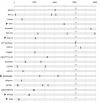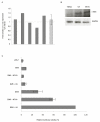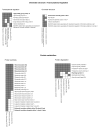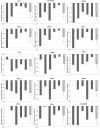Large-scale analysis by SAGE reveals new mechanisms of v-erbA oncogene action
- PMID: 17961265
- PMCID: PMC2194726
- DOI: 10.1186/1471-2164-8-390
Large-scale analysis by SAGE reveals new mechanisms of v-erbA oncogene action
Abstract
Background: The v-erbA oncogene, carried by the Avian Erythroblastosis Virus, derives from the c-erbAalpha proto-oncogene that encodes the nuclear receptor for triiodothyronine (T3R). v-ErbA transforms erythroid progenitors in vitro by blocking their differentiation, supposedly by interference with T3R and RAR (Retinoic Acid Receptor). However, v-ErbA target genes involved in its transforming activity still remain to be identified.
Results: By using Serial Analysis of Gene Expression (SAGE), we identified 110 genes deregulated by v-ErbA and potentially implicated in the transformation process. Bioinformatic analysis of promoter sequence and transcriptional assays point out a potential role of c-Myb in the v-ErbA effect. Furthermore, grouping of newly identified target genes by function revealed both expected (chromatin/transcription) and unexpected (protein metabolism) functions potentially deregulated by v-ErbA. We then focused our study on 15 of the new v-ErbA target genes and demonstrated by real time PCR that in majority their expression was activated neither by T3, nor RA, nor during differentiation. This was unexpected based upon the previously known role of v-ErbA.
Conclusion: This paper suggests the involvement of a wealth of new unanticipated mechanisms of v-ErbA action.
Figures







Similar articles
-
Myb-Ets fusion oncoprotein inhibits thyroid hormone receptor/c-ErbA and retinoic acid receptor functions: a novel mechanism of action for leukemogenic transformation by E26 avian retrovirus.Mol Cell Biol. 1996 Nov;16(11):6338-51. doi: 10.1128/MCB.16.11.6338. Mol Cell Biol. 1996. PMID: 8887663 Free PMC article.
-
Modulation of normal erythroid differentiation by the endogenous thyroid hormone and retinoic acid receptors: a possible target for v-erbA oncogene action.Oncogene. 1992 Feb;7(2):217-27. Oncogene. 1992. PMID: 1347914
-
A conserved C-terminal sequence that is deleted in v-ErbA is essential for the biological activities of c-ErbA (the thyroid hormone receptor).Mol Cell Biol. 1993 Jun;13(6):3675-85. doi: 10.1128/mcb.13.6.3675-3685.1993. Mol Cell Biol. 1993. PMID: 8098843 Free PMC article.
-
The v-erbA oncogene (review).Int J Mol Med. 1999 Oct;4(4):351-8. Int J Mol Med. 1999. PMID: 10493974 Review.
-
The leukaemia oncogene v-erbA: a dominant negative version of ligand dependent transcription factors that regulates red cell differentiation?Cancer Surv. 1992;14:169-80. Cancer Surv. 1992. PMID: 1358441 Review.
Cited by
-
A combination of transposable elements and magnetic cell sorting provides a very efficient transgenesis system for chicken primary erythroid progenitors.BMC Biotechnol. 2009 Sep 18;9:81. doi: 10.1186/1472-6750-9-81. BMC Biotechnol. 2009. PMID: 19765302 Free PMC article.
-
Recruitment of the oncoprotein v-ErbA to aggresomes.Mol Cell Endocrinol. 2011 Jan 30;332(1-2):196-212. doi: 10.1016/j.mce.2010.10.012. Epub 2010 Nov 12. Mol Cell Endocrinol. 2011. PMID: 21075170 Free PMC article.
-
Accessing and integrating data and knowledge for biomedical research.Yearb Med Inform. 2008:91-101. Yearb Med Inform. 2008. PMID: 18660883 Free PMC article. Review.
-
Thyroid hormone receptor mutations in cancer and resistance to thyroid hormone: perspective and prognosis.J Thyroid Res. 2011;2011:361304. doi: 10.4061/2011/361304. Epub 2011 Jun 8. J Thyroid Res. 2011. PMID: 21760978 Free PMC article.
-
The effect of oncoprotein v-erbA on thyroid hormone-regulated genes in hepatocytes and their potential role in hepatocellular carcinoma.Mol Biol Rep. 2011 Feb;38(2):1137-44. doi: 10.1007/s11033-010-0211-2. Epub 2010 Jun 23. Mol Biol Rep. 2011. PMID: 20571909
References
-
- Graf T, Beug H. Avian leukemia viruses: interaction with their target cells in vivo and in vitro. Biochim Biophys Acta. 1978;516:269–299. - PubMed
-
- Casini T, Graf T. Bicistronic retroviral vector reveals capacity of v-erbA to induce erythroleukemia and to co-operate with v-myb. Oncogene. 1995;11:1019–1026. - PubMed
Publication types
MeSH terms
Substances
LinkOut - more resources
Full Text Sources

